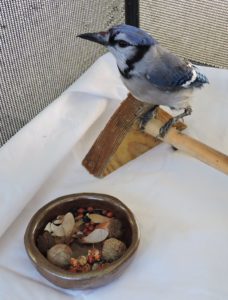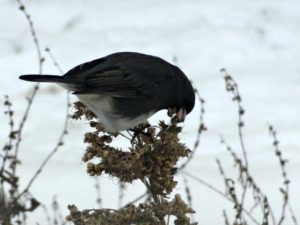Another fun way to provide a unique service to your favorite bird rehabilitator is to create a custom suet for songbirds (and mammals!) in your own kitchen!
Due to illness and stress of the patients, sometimes rehabilitators have a very difficult time getting their patients to eat. This can become a serious, life-threatening issue for wildlife in care. Your rehabber might benefit from a custom made suet full of high calories and native foods—an extra special comfort food to entice the patient to eat! Bird most often attracted to suets are insect eaters.
Below is a basic suet recipe and instructions. Below that, I have listed some seed blends that can be used for some of the most common birds that come to rehabilitation. But here is where your creativity comes in: you can search at the main page for specific songbirds to see what seeds, nuts and berries you feel inspired to create in a suet, then you can get to work in the field and kitchen!
Have fun!
Basic Suet Ingredients
1 lb. beef fat
1 cup cornmeal
3 cups blend of wild seeds, nuts and fruits—of your choice
1 cup or less of natural peanut butter—added as needed or desired
Basic Suet Instructions
- Collect, wash and reuse plastic suet molds. Or use a 2” deep pan as a mold and cut the suet into the correct size blocks to fit the suet feeders at the end. A standard cage-style suet feeder holds a block that is about 4-3/8 inch square by 1-1/4 inch deep.
- Buy slightly over 1 lb. of beef fat from your local butcher– organic is best.
- Prepare the chosen wild seeds, nuts and fruit you want in your suet. Clean the seed, pick out the nutmeats and wash the fruit. Make sure the ingredients are as dry as possible. Mix your chosen wild foods in a bowl and set aside.
- Trim all the meat you can off the fat.
- Chop the fat into small pieces.
- Heat fat in a heavy pan over a low flame stirring occasionally, until the fat is completely liquefied, and don’t leave the kitchen with the fats over a burner. Fats are very flammable, so you want to stay with the stove as the fat melts. No kitchen fires!
- Strain the liquid fat through cheesecloth and feed the meat bits to the dog.
- Once the fat has cooled enough to handle it, add your wild ingredients and the cornmeal and mix thoroughly.
- If needed, add the natural peanut butter, a little at a time, to make the suet a little softer or moister.
- Mix well.
- Pack in molds.
- Let cool in the refrigerator until hardened. Store finished suets in the refrigerator or freezer until you are ready to use them.

Blend Ideas for Common Rehab Bird Species
Here are some ideas to springboard off of depending on what is available at your locale. Search the database yourself, each of these birds have many other options they’ll eat as well!
| Bird
|
Favorite Wild Fruits | Favorite Wild Seeds | Favorite Wild Nuts |
| Catbird | barberry, dogwood, blackberry, cherry, greenbrier, viburnum, autumn olive | none recommended | non recommended |
| Chickadee | serviceberry, sumac, blackberry | pine, birch, hemlock | beech, butternut |
| Blue Jay
|
blackberry, black cherry, bittersweet, black gum, viburnum, firethorn and many others | pine, spruce, hemlock, smartweed, maple | shelled and chopped acorns, black walnuts, hickories, beech nuts, hazelnuts |
| American Crow
|
dogwood, greenbrier, blackberry, holly, black cherry, sumac, redcedar and others | none recommended | shelled and chopped acorns and hickories |
| Northern Flicker | dogwood, black gum, Virginia creeper | mullein, amaranth, ragweed | beech nuts, chopped acorns |
| House Wren
|
bayberry, sumac | none recommended | shelled and chopped butternut, black walnut and acorn |
| Northern Mockingbird | holly, Virginia creeper, elderberry, greenbrier, blackberry | spruce, magnolia | none recommended |
| Northern Cardinal
|
serviceberry, barberry, hawthorn, grape, greenbrier, dogwood | birch, sedge, smartweed, jewelweed, plantain | shelled and chopped, black walnut, beech, hickory and acorn |
Insect-Eating Birds and the Percentage of Insects in their Diet:
The following lists the birds who use insects as more than 30% of their diets, which may indicate something about how likely they would be to utilize suet during rehab. From the Songbird Diet Index by Marcy Scott Rule:
Blackbird, Rusty, 50%
Bluebird, Eastern, 70%
Bobolink, 60%
Bobwhite, Northern, 85%
Bunting, Indigo, 60%
Cardinal Northern, 35%
Catbird, Gray, 45%
Chat, Yellow-breasted, 85%
Chickadee, Black-capped and Carolina, 75%
Creeper, Brown, 95%
Crow, American, 30%
Cuckoo, Black-billed and Yellow-billed, 98%
Dickcissel, 70%
Flicker, Northern, 65%
Flycatcher, Acadian, Alder, Willow, Great-crested, Least, Olive-sided, and Yellow-bellied, 95%+
Gnatcatcher, Blue-gray, 100%
Grackle, 30%
Grosbeak, Blue and Rose-breasted, 50%+
Killdeer, 98%
Kingbird, Eastern, 90%
Kinglet, Golden-crowned and Ruby-crowned, 94%+
Martin, Purple, 100%
Meadowlark, 75%
Mockingbird, Northern, 55%
Nuthatch, Red-breasted and White-breasted, 65%+
Oriole, Eastern and Orchard, 90%
Ovenbird, 98%
Parula, Northern, 100%
Pewee, Eastern Wood, 98%
Phoebe, Eastern, 90%
Pipit, American, 75%
Redstart, American, 95%
Robin, American, 40%
Sapsucker, Yellow-bellied, 50%
Shrike, Loggerhead and Northern, 100%
Sparrow, Chipping, Field, Grasshopper, Henslow’s, Lincoln’s, Savannah, Song, Swamp and Vesper, 40%+
Starling, European, 55%
Swallow, Bank, Barn Cliff, Northern Rough-winged, Tree and Chimney, 80&+
Tanager, Scarlet and Summer, 90%+
Thrasher, Brown, 50%
Thrush, Bicknell’s, Hermit, Swainson’s and Wood, 60%+
Titmouse, Tufted, 65%
Towhee, Eastern, 35%
Veery, 60%
Vireo, Blue-headed, Philadelphia, Red-eyed, Warbling, White-eyed and Yellow-throated, 85%+
Warbler, Bay-breasted, Black-and-white, Blackburnian, Blackpoll, Black-throated Blue, Black-throated Green, Cape May, Chestnut-sided, Hooded, Kentucky,Magnolia, Nashville, Orange-crowned, Palm, Pine, Prothonotary, Tennessee, Worm-eating, Yellow, Yellow-rumped and Yellow-throated, 75%-100%
Waterthrush, Louisiana, 100%
Whippoorwill, 100%
Woodcock, 90%
Woodpecker, Downy, Hairy, Pileated and Red-headed, 50%-80%
Wren, Carolina, House, Marsh and Winter, 95%+
Yellowthroat, 99%

